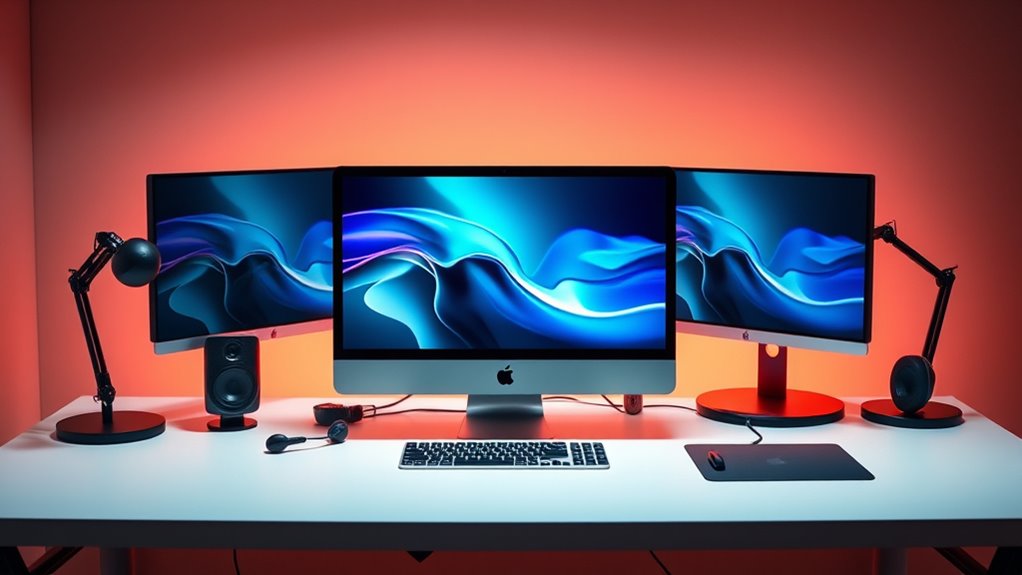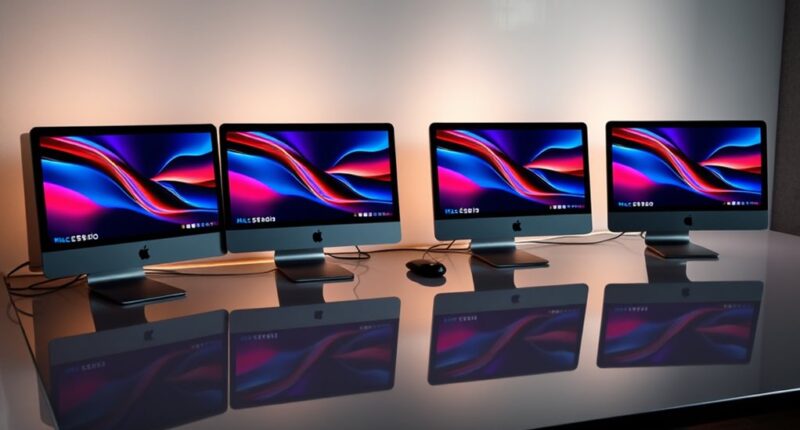For power users demanding top-tier performance, the best Mac Studio models with 128GB+ unified memory are the M4 Ultra, M4 Max, M4 Pro, and the latest configurations with enhanced GPU options. These machines handle demanding workflows like 3D rendering, video editing, and AI tasks smoothly. If you’re curious about specific specs and configurations, keep going—I’ll help you find the perfect fit.
Key Takeaways
- The Mac Studio with M4 Ultra processor supports 128GB+ unified memory for demanding professional workloads.
- Top models feature multi-8K display support and high-performance GPUs suitable for creative and data-intensive tasks.
- Ensure the configuration includes sufficient Thunderbolt, HDMI, and Ethernet ports for extensive connectivity needs.
- These models balance power efficiency with high performance, ideal for future-proofing demanding workflows.
- Custom ordering may be required for 128GB+ memory, affecting availability and cost for power users.
Apple Mac mini Desktop Computer with M4 Chip (512GB SSD, 16GB RAM)
If you’re looking for a compact yet powerful desktop that seamlessly handles demanding tasks, the Apple Mac mini with M4 chip and 16GB of RAM is an excellent choice. Its small size—just 5 inches square—packs impressive performance thanks to the 10-core CPU, 10-core GPU, and 16-core Neural Engine. Despite its tiny footprint, it offers extensive connectivity, including Thunderbolt 4, HDMI, and Ethernet options. The device runs silently, stays cool, and supports multiple high-resolution displays. Perfect for creative professionals and multitaskers, it delivers speed, efficiency, and versatility in a sleek, space-saving design.
Best For: creative professionals, multitaskers, and users seeking a compact yet powerful desktop for demanding tasks and high-resolution displays.
Pros:
- Compact and lightweight design easily fits in tight spaces or next to monitors
- Powerful M4 chip with 10-core CPU and GPU delivers high performance for demanding applications
- Supports multiple high-resolution displays and extensive connectivity options
Cons:
- Lack of USB-A ports requires adapters for some peripherals
- Power button placement at the bottom may be less intuitive
- Base model’s 16GB RAM could be limiting for very intensive workflows
Apple 2024 Mac mini Desktop Computer with M4 Chip
The Apple 2024 Mac mini with M4 chip stands out as an ideal choice for users who need powerful performance in a compact, space-saving design. Its small 5-inch footprint and lightweight build make it perfect for tight spaces, yet it offers impressive hardware—featuring a 10-core CPU, 10-core GPU, and a 16-core Neural Engine. Supported by 16GB of unified memory (expandable to 24GB or 32GB), it handles demanding tasks like video editing and 3D rendering effortlessly. With extensive connectivity options, support for multiple displays, and quiet operation, this Mac mini delivers high performance without sacrificing space or energy efficiency.
Best For: users seeking a powerful, compact desktop that excels in multitasking, creative workflows, and space-efficient setups.
Pros:
- Small, lightweight design perfect for tight spaces and portability
- Powerful M4 chip with up to 20% CPU performance boost and extensive connectivity options
- Quiet operation with minimal noise even under load, ideal for quiet environments
Cons:
- Lack of USB-A ports may require adapters for legacy peripherals
- Base model’s 16GB memory might limit intensive workflow performance
- Power button relocated to the bottom could be less intuitive for some users
Apple Mac mini Desktop Computer with M4 Pro chip
For professionals demanding compact yet powerful computing, the Apple Mac mini with M4 Pro chip stands out as an ideal choice, especially when paired with up to 64GB of unified memory. Its sleek, small design measures just 5 inches square and weighs around 1.5 pounds, making it easy to place anywhere. Powered by the 12-core M4 Pro processor, it offers around 20% faster CPU performance and up to 14% better GPU performance than previous models. With support for up to three displays and fast connectivity options like Thunderbolt 5 and Wi-Fi 6E, it’s perfect for demanding creative workflows and multitasking in a compact form factor.
Best For: professionals and creative users seeking a compact, high-performance desktop capable of handling demanding tasks like video editing, 3D rendering, and AI applications with multiple display support.
Pros:
- Small, sleek, and lightweight design easily fits into any workspace
- Powerful M4 Pro chip with significant CPU and GPU performance improvements
- Supports up to three displays and fast connectivity options like Thunderbolt 5 and Wi-Fi 6E
Cons:
- No USB-A ports, requiring adapters or hubs for older peripherals
- Power button placement on the bottom may be less intuitive
- Base model’s 24GB memory might limit intensive multitasking without upgrades
Apple Mac mini Desktop Computer with M4 Chip and 24GB Memory
Designed for users who need a compact yet powerful desktop, the Apple Mac mini with M4 chip and 24GB of memory offers an impressive balance of performance and portability. Its sleek aluminum design measures just 5 inches square and weighs only 1.5 pounds, making it highly space-efficient. Despite its small size, it provides extensive connectivity, including Thunderbolt 4, HDMI, Gigabit Ethernet, and USB-C ports. Powered by the M4 chip, it delivers around 20% CPU gains and improved GPU performance, supporting demanding tasks like video editing and multitasking. With 24GB of unified memory, it’s well-suited for creative workflows, all while maintaining a quiet, energy-efficient operation.
Best For: users seeking a compact, high-performance desktop ideal for creative work, multitasking, and space-conscious setups.
Pros:
- Sleek, lightweight aluminum design for easy placement and portability
- Powerful M4 chip with significant CPU and GPU improvements for demanding tasks
- Extensive connectivity options supporting multiple high-resolution displays
Cons:
- Lack of USB-A ports may require adapters for older peripherals
- Relocated power button could be less intuitive to find and operate
- Base model with 16GB RAM may limit performance in intensive workflows
Factors to Consider When Choosing a Mac Studio With 128GB+ Unified Memory

When choosing a Mac Studio with 128GB+ of unified memory, I consider my specific memory needs and whether the processor can handle my workload efficiently. I also look at display support options and the available ports to guarantee I can connect all my devices seamlessly. Finally, I evaluate power efficiency levels to find a model that balances performance with energy consumption.
Memory Capacity Needs
Choosing a Mac Studio with 128GB or more of unified memory depends heavily on your specific workload demands. If you handle demanding tasks like 3D rendering or large-scale video editing, extra memory can greatly enhance performance and workflow efficiency. Applications running multiple virtual machines or processing extensive data sets also benefit from higher memory capacity, preventing slowdowns and crashes. Professional users working with large files or complex software suites require 128GB+ to guarantee smooth multitasking and responsiveness. It’s crucial to evaluate your needs based on dataset sizes and the number of applications you run simultaneously. Upgrading to this level of memory not only improves current performance but also future-proofs your setup, accommodating evolving software demands and increasing data complexity.
Processor Compatibility
To guarantee your Mac Studio can handle 128GB or more of unified memory effectively, it’s vital to verify that the processor supports the necessary memory bandwidth and large memory configurations. Look for chips like the M4 Pro or M4 Ultra, which are designed to handle extensive memory pools and high-bandwidth tasks. These processors can efficiently manage demanding workloads such as 3D rendering, large-scale data analysis, and AI applications. It’s also important to confirm the processor supports the latest memory standards and technologies to maximize stability and performance. Additionally, the processor’s architecture should seamlessly integrate with large memory capacities, avoiding bottlenecks. Choosing a compatible processor ensures your Mac Studio can leverage its full potential without hiccups during intensive, multi-threaded tasks.
Display Support Options
Since the processor compatibility guarantees your Mac Studio can handle large memory configurations, it’s also important to evaluate display support options, especially with 128GB+ unified memory. These models can support multiple high-resolution displays simultaneously—often three or more—depending on the configuration. They’re capable of handling 6K displays over Thunderbolt or HDMI connections, perfect for demanding workflows like video editing and 3D rendering. Display support varies based on port types; Thunderbolt 4 and HDMI are essential for connecting high-resolution, high-refresh-rate monitors. The GPU’s capabilities also influence how many displays and resolutions you can run, with higher-end options supporting 8K or multi-8K setups. Ensuring your Mac Studio has the right ports and bandwidth is key to maximizing display performance with 128GB+ unified memory.
Port and Connectivity
When selecting a Mac Studio with 128GB+ unified memory, paying attention to port and connectivity options is vital for supporting your workflow. Make sure the device has enough Thunderbolt 4 or USB-C ports to connect multiple high-speed peripherals and external displays simultaneously. If you plan to use several high-resolution monitors, check for multiple HDMI or DisplayPort outputs. An Ethernet port, preferably with 10Gb support, is essential for fast wired network connections, especially in data-heavy tasks. Additionally, verify the presence of headphone or audio outputs compatible with high-impedance headphones for professional audio work. Finally, consider the number and types of ports to guarantee you can connect legacy peripherals via adapters or hubs, as newer models may lack traditional USB-A ports.
Power Efficiency Levels
Choosing a Mac Studio with 128GB+ of unified memory means considering its power efficiency levels, which directly impact your device’s performance and operational costs. Higher efficiency reduces energy consumption and lowers your electricity bills. Advanced power management features optimize performance during demanding tasks while conserving energy, helping your system run smoothly without wasting power. The use of efficient hardware components also means less heat gets generated, reducing the need for extensive cooling and keeping noise levels down. This not only supports quieter operation but also minimizes wear on internal parts, extending your device’s lifespan. Investing in a model with high power efficiency isn’t just good for your wallet; it’s a smart move toward sustainability and a more eco-friendly workflow.
Software Optimization
Have you considered how software optimization impacts the performance of a Mac Studio with 128GB+ of unified memory? It’s vital because efficient software ensures that this massive memory pool isn’t wasted. macOS is built to fully leverage large memory capacities, allowing seamless multitasking and faster processing for demanding tasks like 3D rendering and video editing. However, to truly benefit, professional applications and development tools need to be optimized for high-memory configurations. Well-optimized software reduces latency and boosts throughput, translating to smoother workflows and shorter load times. Without proper optimization, the impressive hardware potential can be underutilized, limiting productivity gains. So, when choosing a Mac Studio, consider whether your essential software is optimized to take full advantage of the abundant memory.
Budget Considerations
Considering how software optimization affects performance, it’s also important to weigh the financial implications of selecting a Mac Studio with 128GB+ of unified memory. These models tend to be markedly more expensive, often costing several thousand dollars, which can strain budgets. Because of the higher price, you might need to prioritize essential features to avoid overspending. Upgrading to such high memory configurations usually involves custom orders, leading to longer wait times and additional costs. To make a smart choice, evaluate whether your workload truly requires this level of memory. If not, you might find a more balanced setup that meets your core needs without stretching your budget. Being strategic about these costs helps ensure you get the best value for your investment.
Future Upgradability
Since Mac Studio models with 128GB+ unified memory have soldered components, planning for future upgradability is essential. These models don’t support hardware upgrades, so your initial configuration is critical. If you need more memory later, you’ll likely have to buy a new unit, as the memory is integrated directly into the motherboard. Apple’s design emphasizes compactness and performance, which limits the possibility of adding or replacing components after purchase. For power users, this means investing in the highest memory capacity you anticipate needing upfront. While this approach ensures maximum performance for demanding workflows now, it also means you should carefully evaluate your future needs before making a decision, since upgrading later isn’t a viable option.
Frequently Asked Questions
How Does Unified Memory Impact Multi-Tasking Performance?
Unified memory considerably boosts my multi-tasking performance because it allows the CPU and GPU to share the same memory pool seamlessly. This reduces data transfer delays and keeps everything running smoothly even when I have multiple demanding apps open. I notice faster response times, fewer lags, and improved efficiency overall. It’s like having a more organized workspace, making my workflow more fluid and productive.
Are There Upgrade Options for Memory After Purchase?
No, you can’t upgrade the memory after buying a Mac Studio. Apple designs these models with memory that’s soldered onto the motherboard, making upgrades impossible later on. So, I recommend choosing a configuration with enough RAM upfront to meet your needs, especially since power users like us rely heavily on memory for demanding tasks. Planning ahead guarantees you get the performance and capacity you need without regrets.
Which Mac Studio Models Are Best for 3D Rendering?
If you’re diving into serious 3D rendering, I recommend the Mac Studio models equipped with the M2 Ultra chip. They offer a seamless blend of power and efficiency, making complex renders smoother. The higher memory configurations, like 128GB or more, really help handle large files without breaking a sweat. These models are built to keep up with intensive workflows, so you’ll find them perfect for demanding creative projects.
How Does Thermal Management Affect High-Memory Mac Studios?
Thermal management is vital in high-memory Mac Studios because it directly impacts performance and longevity. When I run intensive tasks like 3D rendering, efficient cooling keeps the system from overheating, preventing throttling that slows everything down. Good thermal design ensures the Mac Studio can sustain high workloads without thermal throttling, so I can work longer and more smoothly without worrying about overheating or reduced performance.
What Are the Most Compatible Professional Software Options?
If you’re looking to unlock your Mac Studio’s full potential, you’ll want software that plays nicely. I recommend professional apps like Final Cut Pro, Logic Pro, Adobe Creative Cloud, and DaVinci Resolve. They’re optimized for high-performance Macs and make the most of the vast memory. These programs guarantee smooth workflows, whether you’re editing videos, designing graphics, or composing music, helping you stay productive and inspired.
Conclusion
If you’re serious about releasing unstoppable power, these Mac Studio models with 128GB+ of unified memory are your ultimate weapon. They’ll crush every task, obliterate deadlines, and elevate your creativity to legendary heights. Don’t settle for anything less—dive into these beasts and experience a level of performance that feels like wielding a supercomputer in your hands. Your future self will thank you for choosing these unstoppable machines.











